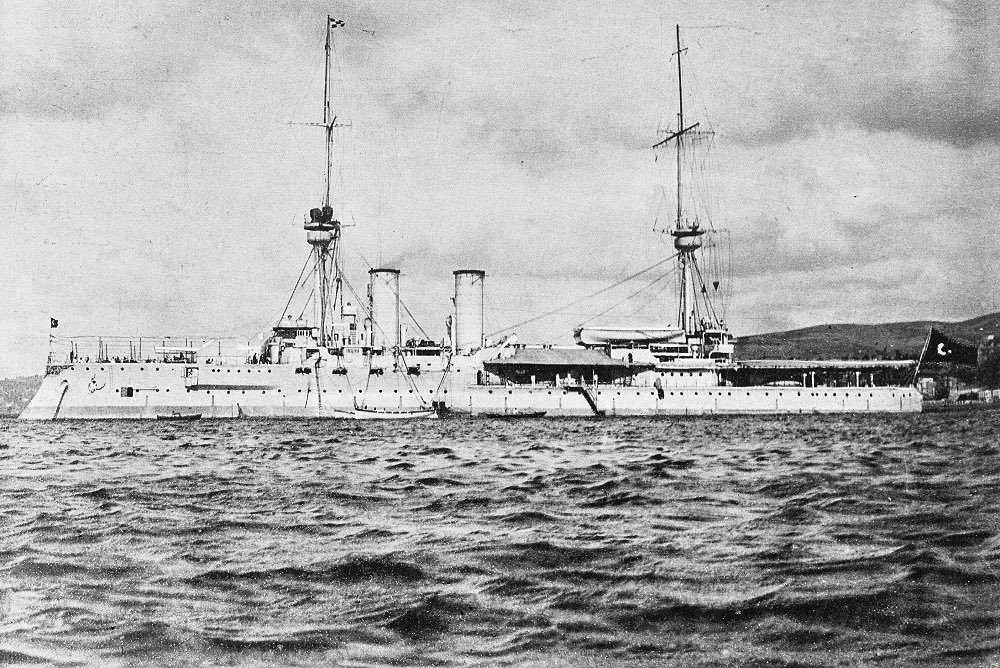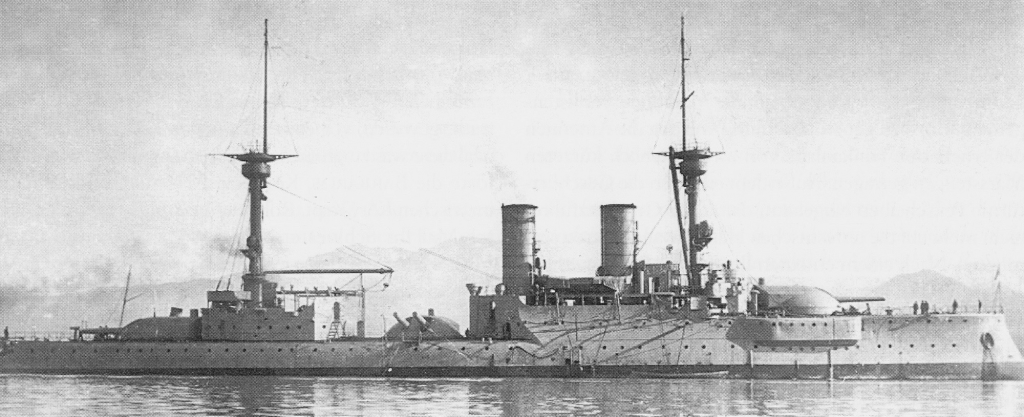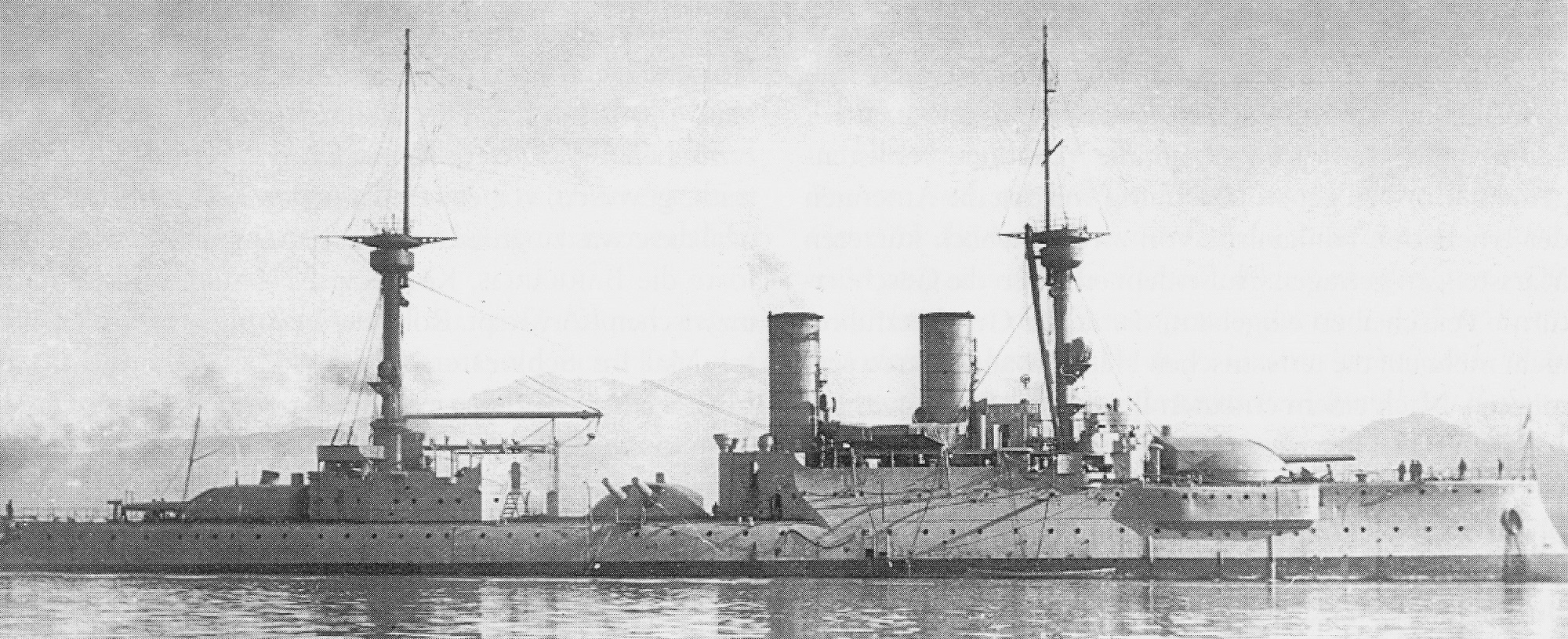Turkish Pre-Dreadnought Battleship Turgut Reis
The Turkish pre-dreadnought battleship Turgut Reis was originally built for the Imperial German Navy as SMS Weissenburg, one of the Brandenburg-class battleships. Weissenburg was launched in 1891 and commissioned into the German Navy in 1894. She, along with her three sisters (Brandenburg, Wörth, and Kurfürst Friedrich Wilhelm), was notable for carrying six heavy guns in three twin turrets, a distinctive arrangement that set them apart from many contemporary designs.
In German service, Weissenburg participated in a number of fleet manoeuvres and served in overseas deployments, including the suppression of the Boxer Rebellion in China (1900–1901). By the early 1910s, however, the Brandenburg-class ships were considered obsolete compared to the dreadnought battleships then entering service. Seeking to modernize its navy but constrained financially, the Ottoman Empire purchased two of the class in 1910—Weissenburg and Kurfürst Friedrich Wilhelm—which were renamed Turgut Reis and Barbaros Hayreddin after famous Ottoman admirals.
As Turgut Reis, the ship became one of the most powerful vessels in the Ottoman fleet, supplementing older ironclads and filling the gap until new dreadnoughts (later seized by Britain at the outbreak of the First World War) could be delivered. During the Balkan Wars (1912–1913), she saw action in engagements against the Greek Navy, including the battles of Elli and Lemnos. Despite her heavy armament, she, like Barbaros Hayreddin, was outclassed by the faster and more modern Greek armoured cruiser Georgios Averof, which dominated the Aegean.
In the First World War, Turgut Reis continued to serve in the Ottoman Navy, though her age and slow speed limited her usefulness. She operated in the Dardanelles and the Sea of Marmara, mostly in a coastal defence role. Unlike her sister Barbaros Hayreddin, which was sunk by a British submarine in 1915, Turgut Reis survived the war.
After 1918, the ship remained in the Turkish Navy but was quickly relegated to secondary duties. She served as a training and accommodation ship through the 1920s and 1930s. Remarkably, she remained in existence until 1950, when she was finally decommissioned and scrapped, giving her one of the longest service lives of any pre-dreadnought.
Actions During the Balkan War
The Ottoman battleship Turgut Reis played a central role in the Balkan Wars, particularly in the naval conflict between the Ottoman Empire and Greece (1912–1913). At this time, the Ottoman fleet was composed of a mixture of older ironclads, pre-dreadnoughts, and cruisers, with Turgut Reis and her sister Barbaros Hayreddin being the most modern and heavily armed capital ships available. The Ottoman Navy’s primary task was to challenge Greek control of the Aegean Sea and to protect Ottoman supply lines and communications across the Dardanelles and into the Balkans.
The Greek Navy, though smaller on paper, had a decisive advantage in the armoured cruiser Georgios Averof, a fast and heavily armed ship that outclassed the Ottoman pre-dreadnoughts in speed, manoeuvrability, and gunnery. This imbalance shaped the course of the naval war.
Battle of Elli (16 December 1912)
The Ottoman fleet, led by Admiral Tahir Bey, sortied from the Dardanelles with the battleships Barbaros Hayreddin, Turgut Reis, Mesudiye, and Âsâr-ı Tevfik, supported by destroyers and smaller vessels. The fleet attempted to force a battle with the Greek Navy near the entrance to the Dardanelles.
At Elli, the Ottoman fleet formed a line of battle with Barbaros Hayreddin and Turgut Reis at the center. The Greeks, under Rear Admiral Pavlos Kountouriotis aboard Averof, intercepted them with a force of three older ironclad battleships (Hydra, Spetsai, Psara) and Averof as the flagship.
During the engagement, Averof demonstrated her superiority. Using her speed, she broke formation with the slower Greek battleships, outflanked the Ottoman line, and raked them with accurate gunnery. Turgut Reis and her sister returned fire, and heavy shelling was exchanged, but Ottoman fire was less accurate. Both Turgut Reis and Barbaros Hayreddin sustained hits, suffering damage to their superstructures and light casualties, but were not seriously crippled. Nevertheless, the Ottoman fleet withdrew back to the safety of the Dardanelles, ceding control of the northern Aegean to Greece.
Battle of Lemnos (18 January 1913)
A month later, the Ottomans attempted another breakout to challenge Greek dominance, this time under the command of Ramiz Numan Bey. The fleet, again centered on Turgut Reis and Barbaros Hayreddin, advanced toward the island of Lemnos, where the Greek fleet lay at anchor.
Once again, Averof took the lead in combat. Using her superior speed (averaging over 20 knots compared to the Ottoman ships’ 16 knots), Averof maneuvered independently, delivering concentrated fire against the Ottoman line. Turgut Reis was heavily engaged during the battle, firing her main batteries repeatedly, but suffered accurate counter-fire from the Greeks. She was struck several times by large-caliber shells, causing structural damage and casualties, though she managed to remain operational. Barbaros Hayreddin took even heavier punishment.
Despite putting up a determined fight, the Ottomans were forced to break off the action and retreat to the Dardanelles once more. The defeat at Lemnos confirmed Greek naval superiority in the Aegean, effectively bottling the Ottoman fleet in the straits for the remainder of the war.
Specifications of Turgut Reis (ex-Weissenburg, Brandenburg-class)
- Displacement: 10,500 tons (normal), up to 11,600 tons (full load)
- Length: 115.7 m (379 ft 6 in)
- Beam: 19.5 m (64 ft)
- Draft: 7.9 m (26 ft)
- Propulsion: 2 × vertical triple-expansion steam engines, 12 coal-fired boilers, 2 shafts, producing 10,000 ihp
- Speed: 16.5 knots (30.6 km/h; 19.0 mph)
- Range: about 4,300 nmi (7,960 km) at 10 knots
- Complement: ~600 officers and men
- Armament (as built):
- 6 × 280 mm (11 in) guns in three twin turrets (two forward, one aft)
- 8 × 105 mm (4.1 in) secondary guns
- 8 × 88 mm (3.5 in) guns
- 6 × 45 cm (17.7 in) torpedo tubes (submerged)
- Armor:
- Belt: 400 mm (15.7 in) amidships
- Barbettes: 300 mm (11.8 in)
- Conning tower: 300 mm (11.8 in)
- Deck: up to 60 mm (2.4 in)







